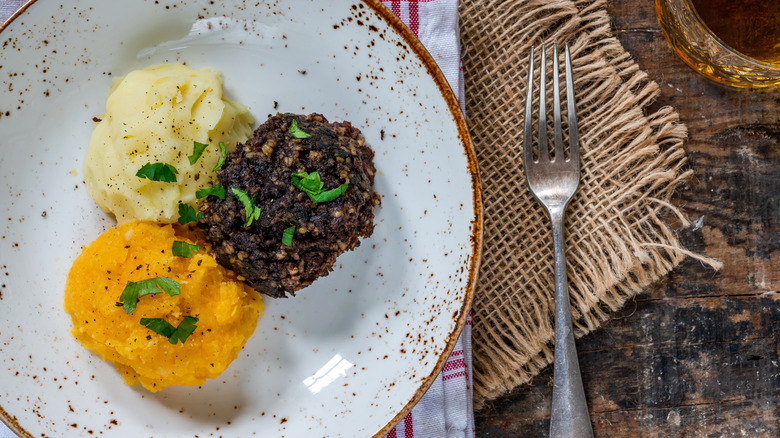The Ingredient That Got Haggis Banned In The US
Nose-to-tail Eating is something that has evolved. Clean Eating defines nose-to-tail Eating as using every part of the animal as a food source. Yes, every part – heads, shoulders, knees, and toes, plus all the organs. Today, many countries still practice this concept because nose-to-tail eating is cost-efficient, sustainable, and ecologically sound. While it was undoubtedly a philosophy our forefathers and early Americans embraced, as the country grew, so did its pickiness regarding food. Suddenly, the only parts of the chicken worth eating were the breasts, thighs, wings, and legs. And why would we eat a cow's liver if we don't have to? Granted, plenty of people still enjoy things like liver, tongue, heart, and other innards (also known as offal), but they are the exception, not always the rule.
Over the past handful of years, more chefs have been embracing offal, whether to emulate certain international dishes or to lessen their carbon footprint. This means that more and more people are experiencing how delicious eating nose-to-tail can be. It's also a wonderful way to explore cultural culinary roots. For example, authentic Mexican Menudo includes tripe (per My Latina Kitchen), or the cow's stomach lining, and French pâté is liver-based. Many of these dishes hold high importance to people and families, and enjoying them is a tradition. Unfortunately, Americans with Scottish heritage have been unable to enjoy authentic Scottish haggis since 1971 due to one particular ingredient.
Leave the lungs out
According to Britannica, haggis is the national dish of Scotland. It is a savory pudding made with a mixture of sheep liver, heart, lungs, beef or mutton suet, oatmeal, and spices. It is put into a sheep's stomach and boiled before it is served. It looks about as appealing as it sounds, often a gray or dark color. According to Scottish Gourmet USA, it is traditionally served with mashed potatoes and yellow turnips. It is an important part of Scottish cuisine. But since 1971, American Scots have endured their haggis without lungs. The U.S. Department of Agriculture (USDA) deemed animal lungs a foodborne-illness risk, as the agency feared that gastrointestinal fluid might leak into the organ during slaughter and processing, per The New York Times.
This does not mean that haggis no longer exists in the United States. On the contrary, haggis can be ordered online and found in specialty shops. But you won't find lung on the ingredient list nor can you import it from the U.K. Critics of the ban claim that, without the organ, the texture is all wrong and that lung creates lightness in the dish, per the BBC. Of course, some people take matters into their own hands and butcher animals to use whatever parts they need. Yes, when it comes to tradition, people will go to great lengths to honor their heritage. And while you may not be ready to be your own butcher, it's worth exploring more nose-to-tail eating.

